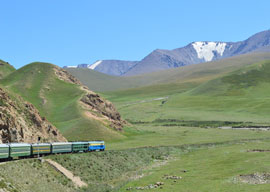
January 21, 2016

Xinjiang, China
Source: Shutterstock
China Daily‘s European issue, Nov. 13″19, 2015, contained an article about how the Silk Road needs watching for “green” standards in the face of so much construction and traffic in the first initiatives of the Silk Road Economic Belt, which include “projects to build enormous networks of road and rail transport lines, energy pipelines and industrial corridors,” wrote Zhang Haiyan. “They follow on the heels of several cargo fast lanes between Chinese inland industrial powerhouses and Western Europe, which have been operational in the past two years, Chongqing-Antwerp, Zhengzhou-Hamburg and Yiwu-Madrid.” As we see, the project is well under way.
In fact, Spain’s secretary of state for trade, Jaime Garcia-Legaz, told China Daily that Spain is keen to be a catalyst in Europe’s relationship with China. It’s a shrewd strategy of the Spanish trade secretary’s, pursuing external economic advantages like the “Belt” despite ongoing domestic stagnation and austerity. Spain already benefits from freight trains originating in Yiwu or Xinjiang reaching Madrid and making the Spanish capital one of several hubs for much of the cross-land trade activity between Europe and China. The first train started operating at the end of 2014. Its departure point, the Chinese city of Yiwu, is in fact the largest wholesale hub for small consumer goods in the world, with a market in which tens of thousands of traders work daily.
The Silk Road Economic Belt raises concerns, too, of course. As Zhang Haiyan, professor and director of Neoma Business Confucius Institute in Rouen, France, warns: “[A] concern of the Western media is the possible transfer of China’s industrial overcapacity to countries along Silk Road and its environmental consequence.”
Who can enforce governance, eco and otherwise, along a thousands-of-miles-long strip of beltway intersecting numerous territories? Nonetheless, the pros outweigh the cons. And meanwhile, as the Silk Road II absorbs $200 billion by 2018, the 21st century already looks like it will be known as the “Chinese Century””a historical turnaround highly visible now, but which William Kirby, Chang Professor of China Studies at Harvard and author of Can China Lead, claims is the product of careful plotting in what has been “100 years in the making.”
Next week, we look at the confrontations or “proxy wars” it’s possible will flare up between Washington, D.C., and Beijing, or Moscow, respectively”in the context of America’s continuing military superpower versus China’s growing military powers.